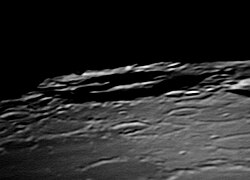 Oblique Lunar Orbiter 4 image | |
| Coordinates | 57°30′N82°00′W / 57.5°N 82.0°W |
|---|---|
| Diameter | 125 km |
| Depth | 3.2 km |
| Colongitude | 86° at sunrise |
| Eponym | Xenophanes |
Xenophanes is a lunar impact crater that is located along the northwestern limb of the Moon. It is nearly attached to Volta, a similar formation to the south-southwest. To the northeast is the smaller crater Cleostratus. Xenophanes is significantly foreshortened when viewed from the Earth, hindering observation.
It is a worn and eroded crater with a battered outer rim that is overlaid by several smaller craters. The rim is a circular range of rugged, irregular ground that is notched in places along the inner wall. A chain of small craters lies along the northern and northeastern rim. At the west end, a pair of clefts in the rim nearly join the floor to the surface beyond. To the northeast, Xenophanes A is an impact crater with a sharp rim and a rough interior.
The interior surface is irregular, but sections have been resurfaced by basaltic lava. A pair of flooded crater rims lie along the southern and northeast sections of the interior. The interior is more level and less rough at the eastern end.
